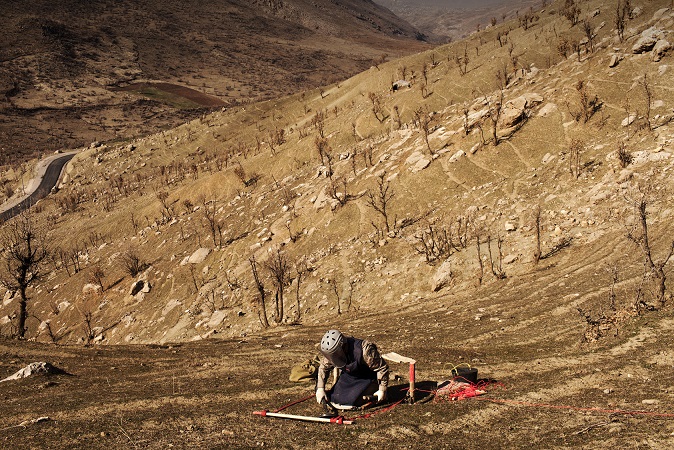In conjunction with the movement to prevent the environmental impacts of armed conflict has come a growing recognition of the need to address the harm that has already occurred. Mine action, which aims to reduce the effects of landmines and explosive remnants of war (ERW), provides a valuable model for assisting victims of and remediating the environment contaminated by toxic remnants of war (TRW).
In this post, part of the War, Law and the Environment blog series with the Conflict and Environment Observatory, Bonnie Docherty of Harvard Law School’s International Human Rights Clinic and Human Rights Watch shows how mine action has influenced the positive obligations in the Treaty on the Prohibition of Nuclear Weapons (TPNW) and argues that it should guide implementation of the TPNW and efforts to deal with TRW more broadly.
Mine action, which aims to reduce the effects of landmines and explosive remnants of war (ERW), has significantly informed recent legal and policy developments related to toxic remnants of war (TRW). It is a core component of humanitarian disarmament, an approach to governing weapons that seeks to remediate as well as to prevent arms-inflicted harm. Although TRW and ERW differ in several ways, mine action offers well-established norms for dealing with the humanitarian and environmental legacies of armed conflict.
This post examines the relevance of mine action to TRW, analyzes the influence of mine action treaties on the victim assistance and environmental remediation obligations in the Treaty on the Prohibition of Nuclear Weapons (TPNW), and explores how mine action law and policy should guide the implementation of the TPNW and efforts to address TRW more broadly. As a humanitarian enterprise that has evolved and expanded over time, mine action provides a valuable model for the development and operationalization of norms to address conflict-related environmental harm.
Relevance of mine action
The effects of armed conflict extend beyond active hostilities due to the explosive and toxic detritus generated by activities related to war. Landmines and ERW, the term used for abandoned and unexploded ordnance, endanger civilians because they can detonate when disturbed years later. TRW ‘form a hazard to humans or ecosystems’ through the ‘toxic or radiological substances resulting from military activities’, which range from weapons testing to combat to military waste disposal.
Mine action was designed for landmines and ERW, but it can guide efforts to mitigate TRW. It seeks to address similar problems for similar reasons with similar activities. First, ERW and TRW both cause immediate and long-term physical injuries, psychological harm, and socioeconomic exclusion. They also deny people access to their land and exacerbate displacement. Second, mine action is motivated by the same humanitarian goals that drive efforts to reduce the environmental impacts of conflict—i.e., to address victims’ needs and ensure their rights can be realized. Third, the mine action pillars of clearance, risk education, victim assistance, and advocacy parallel the remedial measures required to deal with TRW.
Mine action has repeatedly demonstrated its ability to adapt to new challenges by developing and expanding its purview. The field began as a response to a landmine crisis, but now applies to cluster munitions and other types of ERW. Mine action has extended its core activities from clearance to risk education and victim assistance, and its law and policy has grown to include numerous treaties, action plans, and principles. Mine action has also adopted standards to ensure its activities take into account the toxic as well as explosive effects of ERW and are conducted in an environmentally responsible way. Adapting the precepts and practices of mine action to TRW is a logical next step.
TRW present distinct challenges of scope and uncertainty that should be taken into account when applying mine action precedent. Landmines and ERW generally remain in place; TRW can migrate and spread widely. While explosive ordnance injures or kills people at the time of detonation, the effects of TRW are slow to manifest and can, in some cases, be passed on to future generations. Unlike landmines and ERW, which can be seen once uncovered, most TRW are invisible to the naked eye, making it more difficult to assess and protect against the problem. Finally, explosive ordnance can be pinpointed as the cause of an injury, but TRW may increase the risk of a disease without being the sole source. While these characteristics of TRW create some complications, lessons from mine action can help inform a framework for victim assistance and environmental remediation that can be adapted to the TRW context as needed.
Influence on treaty law
Mine action has already significantly influenced the international law relevant to TRW. In 2017, the TPNW became the first treaty to require States parties to address TRW, in this case, contamination from the use and testing of nuclear weapons. While the movement to create the TPNW originated in calls to ban nuclear weapons, proponents, especially within civil society, who had worked on the Mine Ban Treaty or Convention on Cluster Munitions recognized that a comprehensive humanitarian response required measures to deal with the effects of past use and testing. They looked to those instruments as precedent for provisions on victim assistance and environmental remediation in the new nuclear weapons treaty.
The final text of the TPNW was directly informed by the mine action provisions in the Mine Ban Treaty and the Convention on Cluster Munitions. TPNW Article 6(1) on victim assistance copies much of Article 5(1) of the Convention on Cluster Munitions verbatim. The TPNW adds the words ‘without discrimination’, which is in line with the non-discrimination provision of Article 5(2)(e) of the Convention on Cluster Munitions. While the specific harm caused by radiation from nuclear weapons differs from that caused by the explosion of a landmine or submunition, the similarity between the two treaties recognizes that victims need comparable categories of care.
The TPNW draws on the clearance provisions of the landmine and cluster munition treaties in Article 6(2) on environmental remediation. That provision obliges States parties to ‘take necessary and appropriate measures towards the environmental remediation of areas … contaminated’ by the use or testing of nuclear weapons. While less detailed than the clearance articles of the Mine Ban Treaty or Convention on Cluster Munitions, it reflects a core idea of mine action, i.e., that States should address the contamination caused by remnants of war.
The mine action treaties further shaped how the TPNW assigns responsibility for victim assistance and clearance/remediation activities in the TRW context. While a number of States in the TPNW negotiations proposed adopting environmental law’s ‘polluter pays principle’, in the end, negotiating States agreed that it would be more effective to follow the model of previous humanitarian disarmament treaties and oblige affected States parties to play the lead role in addressing harm in their territory. Due to their proximity to affected areas, those States are in a better position to assess victims’ needs and environmental damage, to deliver assistance, and to clear land. This approach also protects affected States’ sovereignty and follows humanitarian disarmament and international human rights law precedent.
At the same time, the TPNW, like the Mine Ban Treaty and Convention on Cluster Munitions, obliges other States parties to provide international cooperation and assistance to help affected States parties meet their obligations. In addition, Article 7(6) explicitly requires user or testing States parties to ‘provide adequate assistance to affected States Parties, for the purpose of victim assistance and environmental remediation’. This provision builds on and expands the concept of user State responsibility found in the Convention on Cluster Munitions by making it an obligation and applying it to victim assistance as well as clearance.
A guide for implementation
Mine action helped shape the TPNW’s victim assistance and environmental remediation obligations and should in turn influence their implementation. Its applicability extends beyond measures to address nuclear weapons contamination under a specific treaty, however. Mine action’s established activities, mechanisms, and principles should also serve as a guide for efforts to respond to the humanitarian and environmental impacts of other forms of TRW.
The pillars of mine action incorporate a range of activities that provide a model for addressing the harm associated with TRW. Victim assistance for explosive ordnance encompasses medical care, rehabilitation, psychological support, and measures to promote socioeconomic inclusion. It is facilitated by the collection of data about victims and their needs and should be sensitive to age and gender. As recognized in TPNW Article 6(1), programs to assist victims of TRW should have the same components. The clearance of landmines and ERW requires, inter alia, an assessment of the problem, precautionary measures to exclude civilians from dangerous areas, risk reduction education, and detonation of the actual ordnance. Environmental remediation of TRW-contaminated areas should follow a similar protocol that includes surveying the situation; preventing civilian exposure, such as by marking and fencing sites or issuing warnings; educating affected communities about risks; and containing, removing, or treating the contamination itself.
The mine action treaties and their associated action plans offer additional guidance for establishing implementation mechanisms. Regarding victim assistance, Article 5(2) of the Convention on Cluster Munitions requires States parties to adopt national plans, appoint government focal points, mobilize resources, and develop and implement relevant national laws and policies. On the subject of clearance of cluster munition remnants, which is analogous to environmental remediation, Article 4(2) obliges States parties to develop plans and mobilize resources. These steps create a foundation for implementation that promotes coordination, accountability, and adequate funding. They should be also adopted for victim assistance and environmental remediation in the TRW context.
Many of the guiding principles that underlie mine action are also relevant to efforts to address the impacts of TRW. First, ensuring inclusivity at all stages of mine action empowers affected individuals and communities and allows them to share their first-hand expertise on the problem and the best ways to address it. Second, upholding the principle of non-discrimination is essential to ensuring affected individuals and communities can enjoy their human rights. Third, transparency, in the form of regular reporting, encourages accountability, facilitates monitoring, and helps illuminate areas where international cooperation and assistance is needed. Finally, accessibility of services and information, which requires a sensitivity to factors such as gender, ability, age, language, and culture, is essential to ensuring victims can take advantage of the programs designed to help them. These guiding principles are equally important to the fairness and effectiveness of victim assistance and environmental remediation measures related to TRW.
While mine action offers valuable guidance for implementing the TPNW’s positive obligations and addressing the impacts of TRW, its models may need to be adapted or expanded in some ways. The activities that constitute mine action are comparable to those used for TRW, but sometimes require different technologies and techniques. For example, TRW survivors often need cancer treatment, rather than prosthetics, and environmental remediation necessitates long-term management because, unlike explosive ordnance, TRW cannot be fully destroyed. From a legal perspective, precedent from other sources can complement that provided by mine action. Given the disproportionate impacts of nuclear weapons testing on indigenous peoples, it would be appropriate to draw on international human rights law and expand victim assistance to protect these groups’ right to culture. The challenges and complexities of remediating TRW contamination warrant taking into account international environmental law’s principle of optimization, which requires weighing the environmental, health, economic, and social costs and benefits of a project before proceeding.
Conclusion
Two recently published sets of principles show how mine action can provide a basis for addressing the impacts of TRW. In Confronting Conflict Pollution, Harvard Law School’s International Human Rights Clinic and the Conflict and Environment Observatory identify principles for assisting victims of TRW. Their 2020 report looks to mine action law and policy for its definitions, types of harm and assistance, framework of shared responsibility, implementation measures, and guiding principles. In 2019, the International Law Commission adopted draft Principles on the Protection of the Environment in Relation to Armed Conflicts, which encompass preventive and remedial measures to reduce conflict-related environmental damage. This document includes principles, drawn in part from mine action, that encourage the provision of relief for environmental damage and call for States to ‘remove or render harmless toxic and hazardous remnants of war . . . that are causing or risk causing damage to the environment’.
The influence of mine action on such efforts to reduce the effects of TRW demonstrates the broad applicability of the field. Mine action was designed to deal with landmines and ERW, but its humanitarian motivations and widely accepted methods have informed developments in the law and policy surrounding TRW. Mine action has provided precedent for new legal obligations to assist victims and remediate the environment in the nuclear weapon context. It should now serve as a guide for implementing the TPNW’s provisions and creating a framework of remedial measures for all TRW in the future.
See also
- Alex Frost, Mitigating the environmental impacts of explosive ordnance and land release, December 16, 2021
- Florian Titze, The nature-security nexus and the UN Security Council, October 14, 2021
- Jani Leino, Bringing IHL home: the protection of the environment in war, October 12, 2021
- Doug Weir & Stavros Pantazopoulos, If not us, who? How States – with the help of civil society – can implement the legal framework protecting the environment from armed conflict, June 10, 2021
- Ahmed Al-Dawoody, Sarah Gale, Protecting the environment during armed conflict: IHL and Islamic law, June 3, 2021






Comments